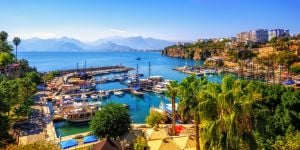
The international travel and tourism industry largely contributes to the global economy, making for 10.2% (or about USD 7,6 trillion) of the annual global GDP. In 2016, the sector accounted for one in ten jobs on the planet, creating 292 million positions — a number which corresponds with the 1.2 billion international arrivals during the same year. While we have been used to North to North travel, outbound travel from Africa, the Middle East, and Asia-Pacific is overgrowing. Here’s an overview of a sector that generates high-quality employment opportunities, bridges people and cultures, and has the potential to promote the protection and restoration of our planet’s ecosystem.
The World Economic Forum has composed the Travel & Tourism Competitiveness Index (TTCI), which measures the sustainable development of the travel and tourism industry of 136 countries. The T&T Competitiveness Index assesses four primary factors, which affect the travel and tourism industry of a nation: the enabling environment (e.g. safety and security, health and hygiene, labour market), policy (international openness, environmental sustainability, prioritisation of the travel industry), infrastructure (air transport, ground and port infrastructure), natural and cultural resources.
Europe and Eurasia

Europe's T&T industry has the best overall performance, with six of the ten most competitive countries being in Europe. In 2016, Europe attracted 620 million of the total 1.2 billion international visitors thanks to good health and hygiene conditions, cultural richness, and high safety levels. Despite a series of recent terrorist attacks, international arrivals declined only temporarily, confirming the resilience of Europe's T&T sector in the presence of firm foundations.
However, even within the same region, there are discrepancies. Southern European countries have more cultural and natural resources and stronger tourism infrastructure, but they lack the business environment, ground transport infrastructure, and environmental sustainability when compared to Western and Northern Europe. Also, the Balkans and Eastern Europe are price competitive but haven't invested enough in air transport and cultural resources. Overall, while Europe's T&T sector continues to improve, the pace is much slower than it is in other less mature regions.
Spain is the most travel and tourism competitive country in the world — a success which can be attributed to the country's cultural richness, an abundance of natural resources, infrastructure, and air transport connectivity. However, there's plenty of space for improvement when it comes to its business environment (ranked 75th) and international openness (ranked 43rd). France ranks in the second position of the T&T Competitiveness Index, with stable international arrivals during the past years, despite losing ground on safety and security. France's cultural resources, ground transportation, and air connectivity are pivotal for the country's high performance, as well as the significant reduction in accommodation prices and ticket taxes.
Italy, which holds the eighth position globally, has some of the world's most remarkable cultural and natural resources, as well as a world-class tourism infrastructure. However, poor investment in brand strategy and an indifferent government to the T&T sector are putting Italy's competitiveness at stake. At the same time, Italy ranks 70th for safety and security due to fear of terrorism and crime, as well as deep mistrust of police operations.
The Americas

In 2015, international arrivals in the Americas reached 201 million, 80% of which arrived in North and Central America and the remaining 20% in Latin America. The majority of the nations in the region attract large populations of travellers thanks to their rich natural resources and traditional hospitality. In general, local governments are doing their part to support the travel and tourism industry, as they seem to appreciate the importance of the sector for the development of their nation.
The United States ranks sixth globally in the Travel & Tourism Competitiveness Index, and it's the most competitive country in the Americas. The US scored highly (16th) for its business-friendly environment, communication and technology (19th), and expert human resources (13th). Also, the country is well-connected by air (2nd) and has excellent tourist service infrastructure (3rd), all of which boost business travel. However, the US's poor environmental sustainability performance (112th) and security concerns are detrimental factors for its travel and tourism development.
Mexico has climbed to the 22nd place in the global ranking, and continues to improve as the government prioritises the T&T industry and invests in the efficient management of natural and cultural resources. On the other hand, Mexico remains an unsafe country (113th), especially within the non-tourist zones. The country should also find ways to balance its further development with the protection of its natural environment, as more indigenous species are threatened.
Asia-Pacific

Asia-Pacific is the second most popular region among travellers, after Europe. The region's international arrivals continue to grow, and most of its countries are improving their travel and tourism-related performance. Socio-economic changes, such as the expansion of the middle class have contributed to the development of the Asia-Pacific area, which primarily relies on its outstanding natural resources and a hard-working labour force. However, it's crucial for the region to incorporate environmental sustainability in its growth plans.
Within Asia-Pacific, there are some noticeable differences. East Asia boasts high safety levels and good health conditions, as well as world-class infrastructure and excellent utilisation of communications and technology. However, East Asia's nations such as Hong Kong and South Korea are some of the most expensive in the region. On the contrary, South-East Asia is much more affordable for international travellers, but its cultural resources aren't promoted as much as its natural.
Japan has rightfully taken the fourth place globally, with international tourists flooding the country for its unique cultural resources, business opportunities, impeccable online services, and first-class ground infrastructure. Even though Japan is mainly an industrialised economy, it does invest in the T&T industry about 4.5% of the annual federal budget. The cost of travelling in Japan remains high, in spite of a substantial decrease in fuel prices and air-ticket taxes. The country has a tight visa policy, undermining its openness, and a weak environmental sustainability strategy, which is unable to resolve the issues of air pollution, overfishing, and the endangerment of certain species.
The Middle East and North Africa

The Middle East and North Africa is the least homogeneous region with some countries ranking at the bottom of security factors, whereas other (e.g. Oman, the UAE, Qatar) ranking at the top ten safest countries in the world. International arrivals in the area are growing thanks to quality infrastructure and investment in information and communications technology. However, in spite of some severe efforts, natural and cultural resources are underexploited, and international openness remains limited.
The UAE's T&T sector is the 29th most competitive in the world, and the number one most competitive in the region with 14.4 million international visitors in 2015. The technologically advanced country offers a first-class business environment and has the third best air transport infrastructure in the world in terms of connectivity and quality. The country is the second most secure destination for visitors but should put more effort into becoming more open and into promoting its natural resources.
Sub-Saharan Africa

Sub-Saharan Africa's T&T industry is the least developed, and the pace of improvement is very slow, considering the size of the continent and its rich cultural and natural resources. Even though the region takes environmental protection quite seriously, there's a significant loss of natural habitat due to deforestation. Southern Africa is the most active sub-region when it comes to travel and tourism initiatives and reception of international visitors, followed by Eastern, and Western Africa.
One of the biggest challenges for travellers is air connectivity and travel costs, which are deficiently regulated, making it almost impossible for regional commercial flying companies to expand. The lack of competition encourages skyrocketing prices of tickets, and airport and landing fees. Precisely, 20 of the 30 Sub-Saharan countries ranked by the World Economic Forum, apply ticket taxes and airport charges above the global average. Only Ethiopia, Kenya, and South Africa which have taken the initiative to sign bilateral agreements have created big state-owned carriers.



















